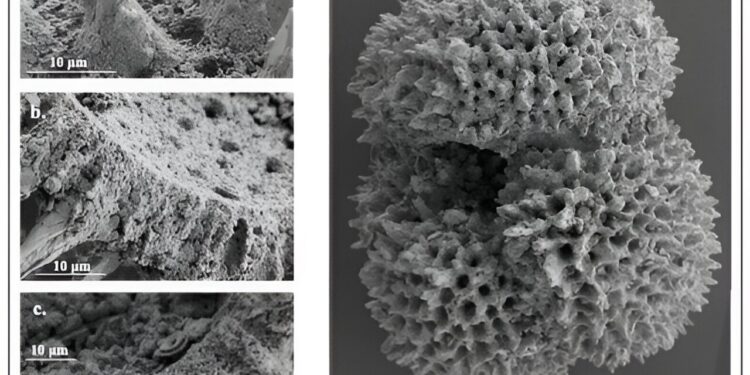Scanning electron microscope images of foraminifera fossils. Credit: Dustin Harper
During the late Paleocene and early Eocene epochs, between 59 and 51 million years ago, the Earth experienced periods of dramatic warming, both gradual periods spanning millions of years and sudden warming events called hyperthermal events.
This global warming is due to massive emissions of carbon dioxide (CO2) and other greenhouse gases, but other factors such as tectonic activity may also have played a role.
New research by University of Utah geoscientists links sea surface temperatures to atmospheric CO levels2 During this period, the two phenomena were closely linked. The results also provide case studies to test carbon cycle feedback mechanisms and sensitivities essential for predicting anthropogenic climate change as we continue to dump greenhouse gases into the atmosphere on a scale unprecedented in planetary history.
The research is published in the journal Proceedings of the National Academy of Sciences.
“The main reason we’re interested in these global carbon release events is that they can provide analogues for future changes,” said the study’s lead author, Dustin Harper, a postdoctoral researcher in the Department of Geology and Geophysics. “We don’t really have a perfect analogue with exactly the same background conditions and the same carbon release rate.”
But the study published Monday suggests that emissions during two past “thermal maxima” are similar enough to current anthropogenic climate change to help scientists predict its consequences.
The research team analyzed microscopic fossils, recovered from drill cores taken from a Pacific sea shelf, to characterize the chemistry of the ocean surface at the time the shelled creatures were alive. Using a sophisticated statistical model, they reconstructed sea surface temperatures and atmospheric CO.2 levels over a 6-million-year period that spanned two hyperthermias, the Paleocene-Eocene Thermal Maximum, or PETM, 56 million years ago and the Eocene Thermal Maximum 2, ETM-2, 54 million years ago.
The results indicate that atmospheric levels of CO2 Global temperatures have risen, as have winter temperatures.
“Our planet and our atmosphere are influenced by CO in multiple ways.2 additions, but in each case, regardless of the source of CO2“We’re seeing similar impacts on the climate system,” said co-author Gabriel Bowen, a professor of geology and geophysics at the University of Utah.
“We are interested in the sensitivity of the climate system to these changes in CO2. And what we see in this study is that there is some variation, perhaps a little bit lower sensitivity, a little bit lower warming associated with a given amount of CO.2 “We can’t help but see the very long-term changes. But overall, we see a common range of climate sensitivities,” Bowen said.
Today, human fossil fuel activities are releasing carbon 4 to 10 times faster than during these ancient hyperthermal events. However, the total amount of carbon released during these ancient events is similar to the projected range for human emissions, potentially giving researchers a glimpse into what might await us and future generations.
Scientists must first determine what happened to the climate and oceans during these episodes of global warming more than 50 million years ago.
“These events could represent a worst-case or medium-term scenario,” Harper said. “We can study them to determine what environmental change is occurring because of this release of carbon.”
The Earth was very warm during the PETM. There were no ice caps covering the poles and ocean temperatures were around 32°C.
To determine oceanic CO2 To reach these levels, the researchers turned to fossilized remains of foraminifera, a single-celled, shelled organism related to plankton. The research team based its study on cores previously extracted by the International Ocean Discovery Program from two locations in the Pacific.
Foraminifera shells accumulate small amounts of boron, whose isotopes are an indirect indicator of CO2 concentrations in the ocean at the time the shells formed, Harper said.
“We measured the boron chemistry of the shells and we are able to translate these values using modern observations to past seawater conditions. We can obtain data on the CO2 in the seawater.2 and translate this into atmospheric CO2“, Harper said. “The goal of the target study interval was to establish a new CO2 and the temperature records for the PETM and ETM-2, which represent two of the best analogues in terms of modern change, and also provide a longer-term background assessment of the climate system to better contextualize these events.”
The cores Harper studied were taken from the Shatsky Ridge in the subtropical North Pacific, an ideal location for recovering ocean-floor sediments that reflect conditions in the ancient past.
Carbonate shells dissolve as they settle in the deep ocean, so scientists must turn to underwater plateaus like the Shatsky Ridge, where water depths are relatively shallow. While their inhabitants lived millions of years ago, foraminifera shells record sea surface conditions.
“Then they die and sink to the bottom of the sea, and they’re deposited about two kilometers down,” Harper said. “We’re able to recover the entire sequence of dead fossils. In these mid-ocean locations, there’s not really a lot of sediment from the continents, so it’s mostly these fossils and that’s it. It’s a really good archive for what we want to do.”
More information:
Harper, Dustin T., Long- and short-term coupling of sea surface temperature and atmospheric CO2 during the late Paleocene and early Eocene, Proceedings of the National Academy of Sciences (2024). DOI: 10.1073/pnas.2318779121
Provided by the University of Utah
Quote:Microscopic fossilized shells reveal ancient patterns of climate change (2024, August 26) retrieved August 26, 2024 from
This document is subject to copyright. Apart from any fair dealing for the purpose of private study or research, no part may be reproduced without written permission. The content is provided for informational purposes only.



